WATERFRONT BLUES FESTIVAL
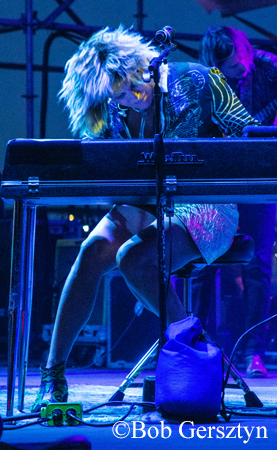
Grace Potter
A Great Return to Form For a Musical Tradition
Article and photos by Bob Gersztyn
(October 2022)
The Waterfront Blues Festival is an annual event that occurs every July 4th weekend since it began in 1987 with John Lee Hooker headlining. Over the years the festival has featured headliners like Gregg Allman, Buddy Guy, Isaac Hayes, Steve Miller and Robert Plant to name a few.
This year it was celebrating its 35th year as it resumed in its normal location on the banks of the Willamette River at Tom McCall Park in downtown Portland, Oregon. During the COVID lockdown, the festival still occurred in a restricted manner that complied with masking and social distancing.
In 2020, the festival was cancelled as a large group event but the innovative blues musicians of Portland created the "Blues Fest Bandwagon." A van full of musicians would drive to different neighborhoods around the city and park in cul-de-sacs and on street corners where they would kick out the jams. They did this for two days and their performances were broadcast on local radio station KBOO.
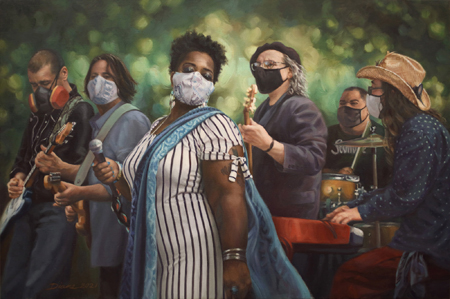
Diane Russell artwork
Portland resident Diane Russell has been photographing the festival for decades and uses the images to produce fine art paintings of blues artists. During the COVID lockdown, Diane caught one of the mini concerts and was inspired to paint "COVID Blues" which has been selected by the "Portrait Society of America" competition for members only as a finalist for the second year in a row.
In 2021, the festival resumed in a different location using two, four and six person socially distanced pods while wearing masks. The crowd capacity was limited to a couple thousand people rather than the normal twenty thousand. Instead of an all day event, there were two different performances by the same cadre of artists each day. To reach as wide an audience as possible, performances were live streamed on the internet all four days by Portland's local TV station, KOIN 6 as well as KBOO local public radio. Artists ranging from Samantha Fish and Marc Broussard to Curtis Salgado and Ty Curtis headlined on different days.
So for the first time since 2019, the festival was in full swing, with four stages presenting over one hundred different acts. The main headliners on the two largest stages ranged from Taj Mahal and the Phantom Blues Band to Grace Potter and the Nocturnals along with Curtis Salgado, Robert Randolph, Big Monti Amundson and dozens of others. The two secondary stages featured everything from World music to Zydeco along with newer acts, solo acts and workshops. If that wasn't enough, there was also a blues cruise ship called the Portland Spirit which took two hour voyages on the Willamette River with multiple blues acts performing.
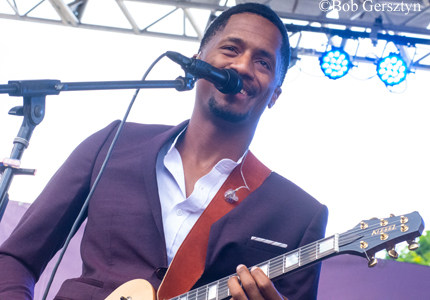
Ron Artis
One of the newer acts that impressed me was Ron Artis II and the Truth. Ron is originally from Hawaii but relocated to Portland after becoming one of the top acts on the island. After gaining the attention and support of top tier artists like Mick Fleetwood, Jack Johnson and Booker T. Jones, who encouraged him to share his music, he began recording and expanding his world. He was the eldest of eleven children and grew up in a home strongly influenced by both religion and music. He and his band performed multiple genres as they mesmerized the crowd with everything from hard driving guitar driven blues rock to soulful gospel, R&B and soul (you can hear more at Ron's website).
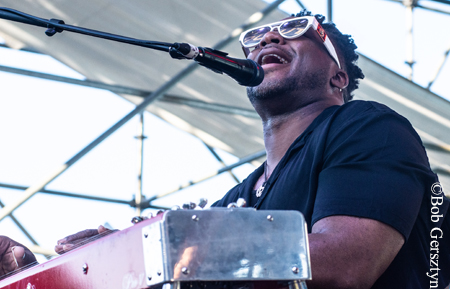
Robert Randolph
Another act that I'd been wanting to see for quite a while was Robert Randolph and the Family Band. Robert learned to play the pedal steel guitar in Nashville where he attended The House of God Church Keith Dominion. The unique sound of Sacred Steel Music is intrinsically associated with the House of God Church and is the lead instrument in their unforgettable worship services. Randolph was nominated for four Grammy Awards and has released six studio albums as well as making over two-dozen guest appearances on the albums of other artists as well as soundtracks.
When the Robert Randolph Band exploded onto the stage, it did not disappoint as they rocked the house with Robert producing amazing sounds with his instrument. The band consisted of drums, bass guitar, keyboards, a backup singer and a second lead guitar with a standard six string. Between the two guitarists, they rocked stratospherically on a series of instrumentals that traversed from blues to funk and gospel. Randolph sang a funky song about his baby brother that turned into a long funky jam that ended in another amazing guitar solo duet followed by "I'm So Glad," a popular Skip James cover that was followed by "I Need More Love" that climaxed with a Hendrix-influenced conclusion.
You have to be prepared to do a lot of walking if you want to see every act which is impossible since they are occurring simultaneously at opposite ends of the park. One way to actually see them all is to just catch the first half of their act before you leave to catch the last half of another act. A large dance floor is always full of people boogieing to the beat of the backstage with Zydeco or the Afro-rhythms of groups like Loveness Wesa originally from Zimbabwe and Mason Trail & Zydeco Rhythm from Louisiana, whose sound reminded me of Los Lobos.
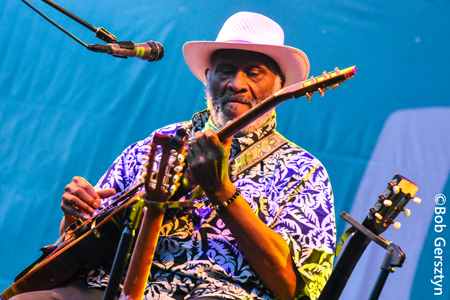
Taj Mahal
Another anticipated act was Taj Mahal, a classic blues artist that began his career back in the 1960's. Since then, he has won Grammys and recorded dozens of albums. Fifty-four years later, he was still performing and keeping the blues tradition alive as he dove into "Diving Duck Blues."
Grace Potter and the Nocturnals took the stage by storm as Potter grabbed the microphone and proceeded to perform a sexually charged set. Her rambunctious theatrics reminded me of a female version of David Lee Roth. Whether she was enticing the audience with "Paris (Ooh La La)" as she gyrated with the microphone stand or sat slouching on the bench of her electric piano heartfully singing Etta James' hit song "I'd Rather Go Blind," her performance was spellbinding.
The festival seemed to be pretty much back to pre-pandemic normal and the attendance was maxed out. With the price of concert admission skyrocketing out of control with artists like Bon Jovi and Bruce Springsteen charging thousands of dollars, festivals are a way to consolidate the cost and give the attendee more bang for their buck. Today, there are festivals for every genre but in the beginning, the first festivals were acoustic blues and folk. Electrified rock didn't manifest itself in festival form until after Bob Dylan played an electric set at the 1965 Newport Folk Festival and the Monterey Pop Festival two years later. We should consider ourselves fortunate that blues festivals like Waterfront are still able to thrive.